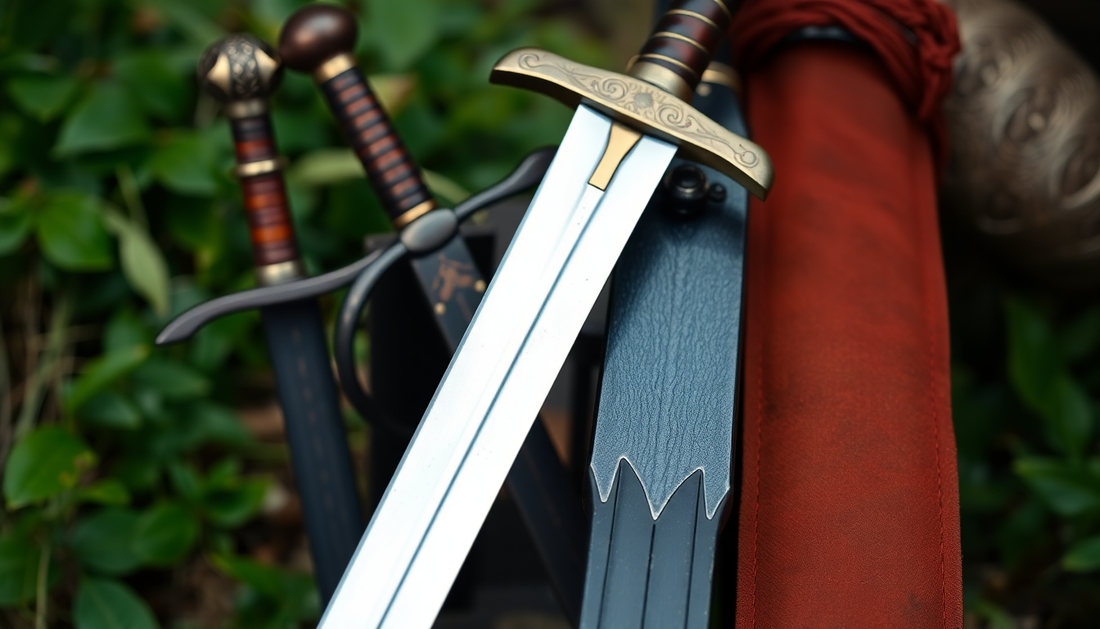
Battle-Ready vs. Decorative Medieval Swords: Which is Right for You?
Share
Battle-Ready vs. Decorative Swords: Which is Right for You?
The world of medieval swords is both fascinating and diverse. Whether you are a collector, reenactor, or simply a history enthusiast, understanding the differences between battle-ready and decorative swords is crucial. This knowledge will help you make informed decisions, leading to a more satisfying purchase. In this guide, we will delve into sword styles, their purposes, and how to choose the right one for your needs.
Understanding Medieval Sword Styles
Types of Medieval Swords
Medieval swords can be grouped into several styles, each with unique attributes. The most popular types include longswords, broadswords, and arming swords. Longswords feature a double-edged blade and can be used with both hands, making them versatile. Broadswords, on the other hand, tend to have a wider blade, providing more cutting power. Each sword type serves a different purpose and is designed for specific combat techniques.
Features of Each Style
The usability and aesthetics of a sword are largely influenced by its style. For instance, a longsword is known for its balance and reach, while a broadsword excels in delivering powerful slashes. Understanding these features helps potential buyers identify which style suits their needs. If you are interested in combat or reenactment, certain sword styles may be more practical than others.
What Are Battle-Ready Swords?
Definition and Purpose
Battle-ready swords are specifically designed for real combat situations. These swords are crafted to withstand rigorous use, making them suitable for training, reenactment, or even actual combat. Characteristics that define a battle-ready sword include a strong, sharp blade and a robust hilt designed for secure grip.
Hand-Forged Swords
One of the most sought-after features in battle-ready swords is the hand-forged craftsmanship. Hand-forged swords are made from high-quality steel, ensuring durability and performance. The process involves heating the metal and shaping it manually, resulting in a unique blade that maintains its strength and integrity over time. This level of craftsmanship typically offers a better performance compared to mass-produced items.
Pros and Cons of Battle-Ready Swords
Before committing to a battle-ready sword, it’s essential to weigh its pros and cons. On the positive side, these swords are built for functionality, which makes them ideal for reenactments or martial arts training. However, they can require more maintenance, and their cost may be higher compared to decorative options.
The Allure of Decorative Swords
Characteristics of Decorative Swords
Decorative swords serve a different purpose. While they may not be suitable for combat, they are crafted with intricate designs and aesthetic appeal. Features often include ornate hilts, detailed engravings, and vibrant finishes, making them perfect as display pieces.
Uses of Decorative Swords
Collectors, interior decorators, and history enthusiasts often choose decorative swords for their visual appeal. These swords can elevate a room's decor or serve as conversation starters. Some collectors enjoy the artistry and historical significance of valuable pieces, making their collection unique.
Pros and Cons of Decorative Swords
While decorative swords serve to beautify, they lack the functionality of battle-ready swords. The benefit lies in their artistic value and safer handling. However, should you buy a sword intended for use in demonstrations or reenactments, a decorative sword may not meet your requirements, as they are generally not designed for heavy use.
Choosing the Right Sword for Reenactment
What to Look For
If reenactment is your goal, certain features are essential to consider. A suitable reenactment sword should look authentic and be made of durable materials, ideally one that is battle-ready. Additionally, the sword should feel comfortable in your hand, and the weight should be manageable enough for extended use.
Understanding Your Needs
In reenactment, striking a balance between personal preference and historical accuracy is critical. Research the specific period or style you are portraying, as different eras and regions utilized various sword designs. Seek authenticity to enhance your reenactment experience.
How to Decide: Battle-Ready vs. Decorative
Assessing Your Intentions
When deciding between battle-ready and decorative swords, your purpose should guide your choice. If you are interested in using the sword for training or reenactment, a battle-ready sword is likely the best option. On the other hand, if your interest lies more in aesthetics and decor, a decorative sword would be more suitable.
Tips for Making a Choice
Consider factors such as your budget, space for display, and how much maintenance you are willing to undertake. If you are serious about martial training or reenacting, invest in a quality battle-ready sword. For casual collectors or decorators, beautiful decorative swords can add charm without the need for maintenance.
Conclusion
In summary, both battle-ready and decorative swords have their rightful place in the world of medieval weaponry. Understanding the key differences can guide you in choosing the best medieval sword for your needs. Whichever path you choose, whether it's for reenactment or a beautiful display, enjoy the rich history these swords bring into your life and collection. At Knight's Collection, we offer a wide range of premium swords crafted with authenticity and craftsmanship. Shop with us today and discover the perfect sword to suit your individual style and purpose.
